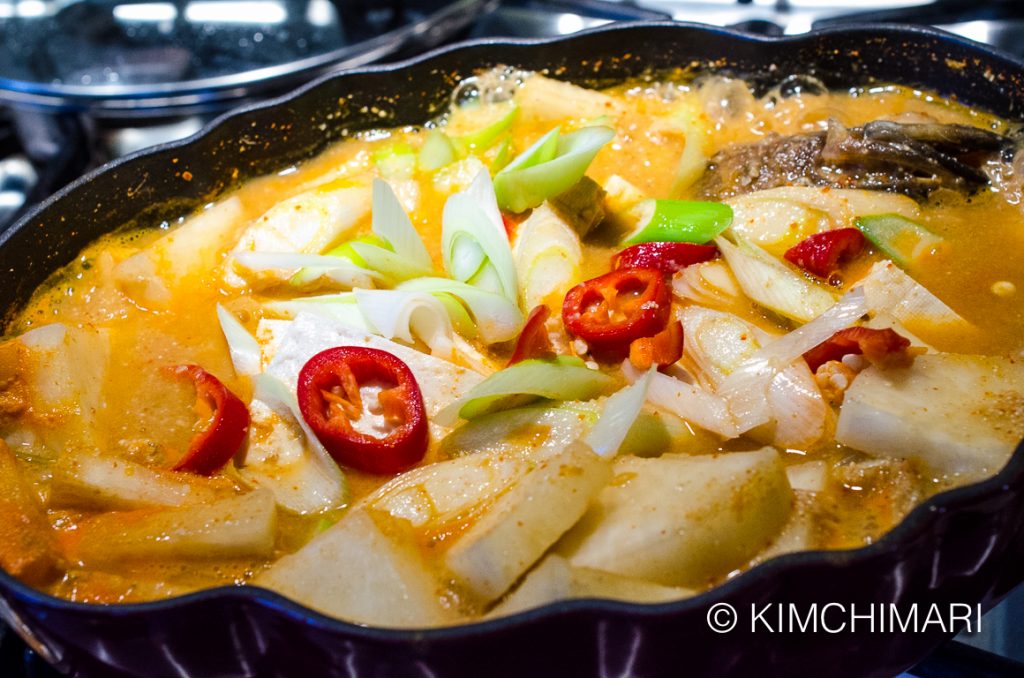
Alaska Pollock Stew or Dongtae Jjigae is a very popular Korean fish stew that is made with frozen Alaska pollock. I have shared in my Bugeo Gui recipe about how Koreans use different words to describe Alaska pollock in different states – fresh, frozen, dried, semi-dried.. Alaskan pollock is such an important ingredient in Korean cuisine that there are unique names (6 in all!) for all the different ways the fish comes in. Dongtae 동태 (frozen), Bugeo 북어 (dried), and so on.

See my post on Bugeo Gui for more info on Alaskan pollock and also for a fabulous way to pan sear dried pollock!
As you may have guessed, the ‘dong’ in Dongtae (동태 凍太) means ‘frozen’. And I don’t know why this phrase suddenly comes to my head but Koreans talk about someone’s eyes looking like ‘frozen pollock eyes’ = ‘동태눈’…hahaha…which is really not a nice thing to say (bad JinJoo!) because it basically means someone’s eyes looking lifeless and hazy. Usually referring to someone who is exhausted from staying up all night or often someone who had a little too much to drink the night before. Yeah..I’m sorry but I just couldn’t resist. 😝 I am just too honest sometimes… hahaha..
I probably mentioned before that my father loved seafood and Dongtae Jjigae was one of his favorite Jjigae to have at home. And although my mom was not a fan of fishy fish like mackerel (고등어) or herring (청어), she was also a fan of this Alaska pollock stew. I always remember my mom emphasizing to us that in order for the Frozen Alaska Pollock Stew to taste good, you have to chop up and include something called Iri (이리). All this time, I thought Iri was some part of the pollock’s stomach. Silly me…
And until now, all the frozen pollock I bought at Korean markets in the US always had this Iri. But when I bought dongtae from our market recently to cook for this post, for the life of me, I could not find Iri!! All that fish had were huge sacs of eggs besides the usual innards. Hmm…have I lost my marbles?? Was I just mistaken? I was totally puzzled…
I asked my sister and I even asked a retired deli owner in our church who is one of the best cooks that I know in the area (she used to serve a bibimbap salad that was quite addicting) and they all could not give me a clear answer why I could not find Iri in my dongtae.
Hmm.. I was lost…
Did I dream this whole Iri thing up? Did I somehow accidentally discard it? So I bought another fish..
Is our local market selling a different fish disguised as an Alaska pollock? Koreans have been found to sell different fish you know – there was a scandal while back where people sold a similar variety to the very expensive yellow croaker (Gulbi 굴비) and colored the belly yellow. Embarrassing..
Does this organ Iri shrink somehow when the pollock fish is full with eggs???
I was going crazy.. and started searching online and couldn’t find much for some time. And then… well, SURPRISE!!! I found out that Iri is actually the organ that holds the sperm (testicle) of the male pollock!!! So, DUH… of course, it will be missing in a fish that has eggs – aka FEMALE.. hahaha. Iri is the white, squiggly brain-like organ on the right in the picture below.
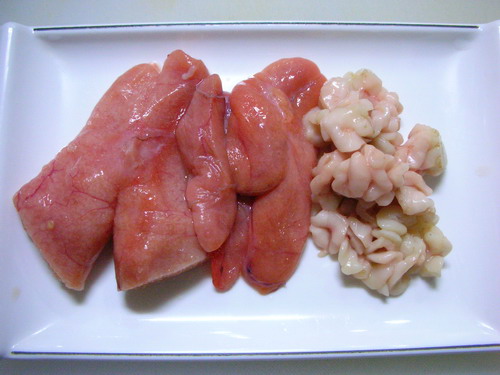
I ended up buying 3 dongtae from my local market in the search of the Iri but they were all female with only the egg sacs (on the left in the pic above) which is called Al 알 or Goni 곤이. FYI, this egg sacs are used to make Myeongranjeot (명란젓) – one of my most favorite food!!!
Wow – stick with me and you will learn something new everyday!
Right, let’s get cooking shall we??
Frozen Alaska Pollock Stew (Dongtae Jjigae 동태찌게)
Servings: 3 Prep Time: 10 min Cook Time: 25 min Difficulty: Medium
Ingredients
- 1 whole frozen or fresh pollock (Dongtae)
- 1 small radish, cut into squares (2 cups)
- 1/2 pack (6-8 oz) of extra firm tofu
- 4 cups rice water
- 1 small bunch minari (water dropwort)
- 5-6 stalks ssukgat (crown daisies)
- 1 red chili pepper, sliced
- Seasoning
- 2 tsp deonjang (Korean soybean paste)
- 4~5 tsp gochujang
- 1 Tbs guk ganjang (Korean soy sauce for soup)
- 2 Tbs garlic, chopped
- 1 Tbs cooking rice wine or sake
- 1 Tbs gochukaru (Korean chili powder)
- 1/2 tsp ginger, grated
- 2 tsp saewoojeot (fermented shrimp)
- 1/4 tsp sea salt (Trader Joe’s)
- Clean the fish. Cut all fins, tail with scissors. And then remove gills (on both sides), take out the innards along with the egg sac (or the sperm sac Iri if male). Save egg sac or Iri, liver and set aside. Rinse the gutted fish and then cut fish into 4-5 pieces. Set aside. I made a quick how-to video on how to gut the fish. Note – I did not separate the liver because it kind of looked damaged but you are welcome to add that to your stew.Cleaning Alaska Pollock for Dongtae Jjigae
- Peel radish and cut into thick slices and then into squares. Cut tofu into similar size squares too.
- Rinse and cut green onions, red chili pepper, minari and ssukgat.
Vegetables for Dongtae Jjigae – Spicy Alaska Pollock Stew - Chop garlic and grate ginger. I used a ginger grater that I have but you can use any grater.
Ginger grated for Jjigae - In a pot, add pollock pieces, egg sac (roe), liver (if you want) and radishes.
Alaska Pollock in pot for Dongtae Jjigae - Add 4 cups of rice water.
Alaska Pollock in rice water for Stew - Add all seasoning to the stew – garlic, ginger, chili powder, cooking sake, doenjang, gochujang, saewoojeot and guk ganjang.
Alaska Pollock stew (Dongtae Jjigae) seasoning - Bring to stew to boil and cook on medium high heat for 10 minutes. Add tofu. Cook another 5-7 minutes until fish is fully cooked. Taste and add the salt. Adjust seasoning.
- Add ssukgat, green onions, minari and red chili slices on top. Turn off heat.
Spicy Alaska Pollock Stew with gochujang - Serve with rice and other side dishes.
Notes
- You can use plain water or anchovy stock instead of rice water.
Spicy Alaska Pollock Stew - Dongtae Jjigae
Ingredients
- 1 whole frozen or fresh pollock (Dongtae)
- 1 small radish (cut into squares) (2 cups / 500 ml)
- 6-8 oz extra firm tofu (1/2 pack)
- 4 cups rice water
- 1 bunch minari (water dropwort)
- 5-6 stalks ssukat (crown daisies)
- 1 red chili pepper (sliced)
Seasoning
- 2 tsp doenjang (Korean soybean paste)
- 4-5 tsp gochujang
- 1 Tbsp guk ganjang (Korean soy sauce for soup – shop)
- 2 Tbsp garlic (chopped)
- 1 Tbsp cooking rice wine or sake (shop)
- 1 Tbsp gochukaru (Korean chili powder)
- 1/2 tsp ginger (grated)
- 2 tsp saewoojeot (fermented shrimp)
Instructions
- Clean the fish. Cut all fins, tail with scissors. And then remove gills (on both sides), take out the innards along with the egg sac (or the sperm sac Iri if male) and set aside. Rinse the fish and cut into 4-5 pieces. Set aside.
- Peel radish and cut into thick slices and then into squares. Cut tofu into similar size squares.
- Rinse and cut green onions, red chili pepper, minari and ssukgat.
- Chop garlic and grate ginger.
- In a pot, add pollock pieces and radishes.
- Then add 4 cups of rice water.
- Add to pot- garlic, ginger, chili powder, cooking sake, doenjang, gochujang, saewoojeot and guk ganjang.
- Bring everything to boil and cook on medium high for 10 minutes. Add tofu.
- Cook for 5 - 7 minutes until fish is fully cooked.
- Garnish with ssukgat and minari. Turn off heat and serve.
Tips & Notes:
Serve with rice and other Korean side dishes.
Nutrition Information:
Enjoy!
XOXO,
JinJoo
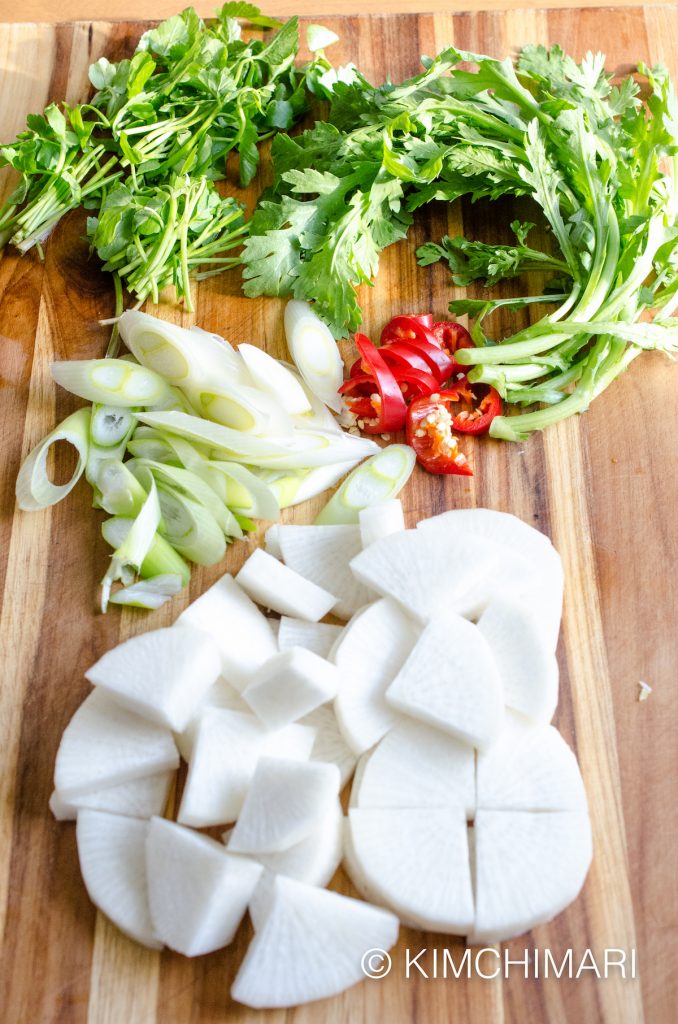
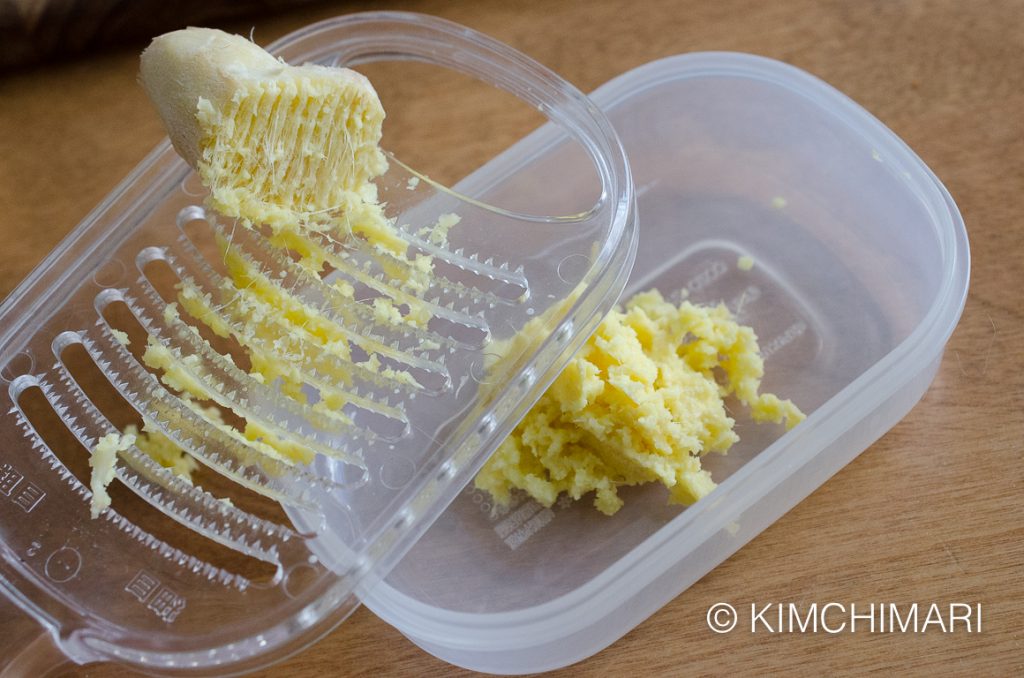
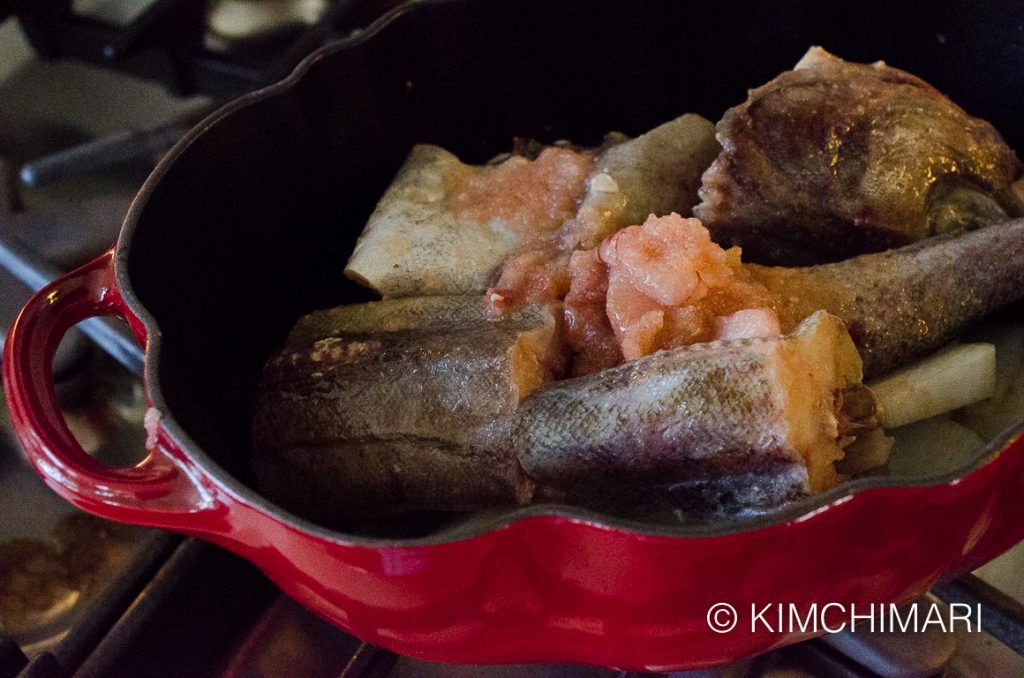
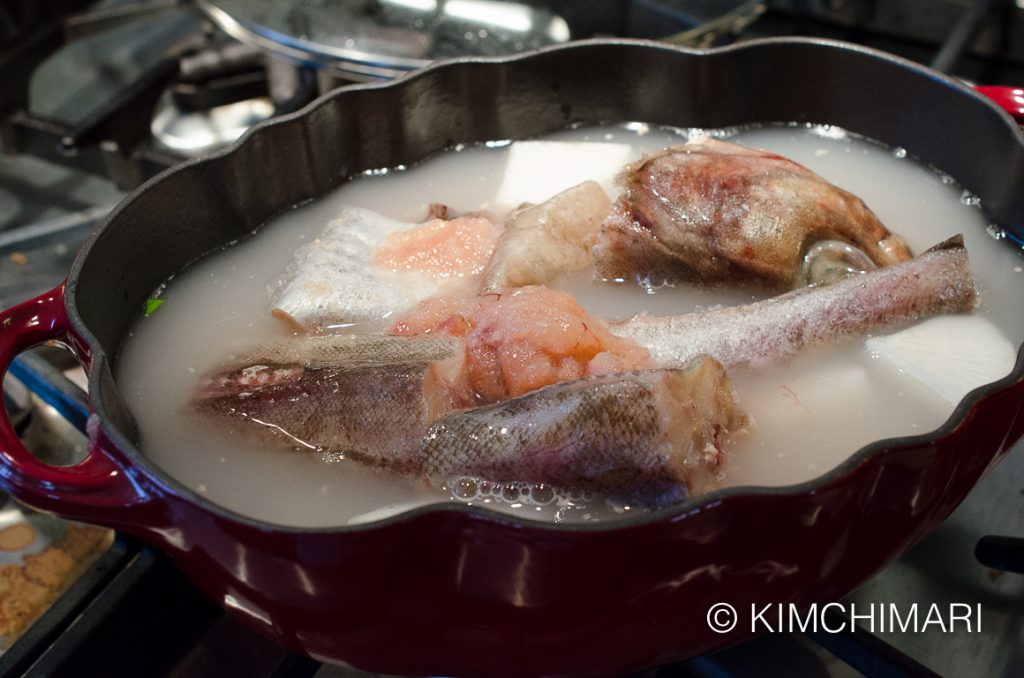
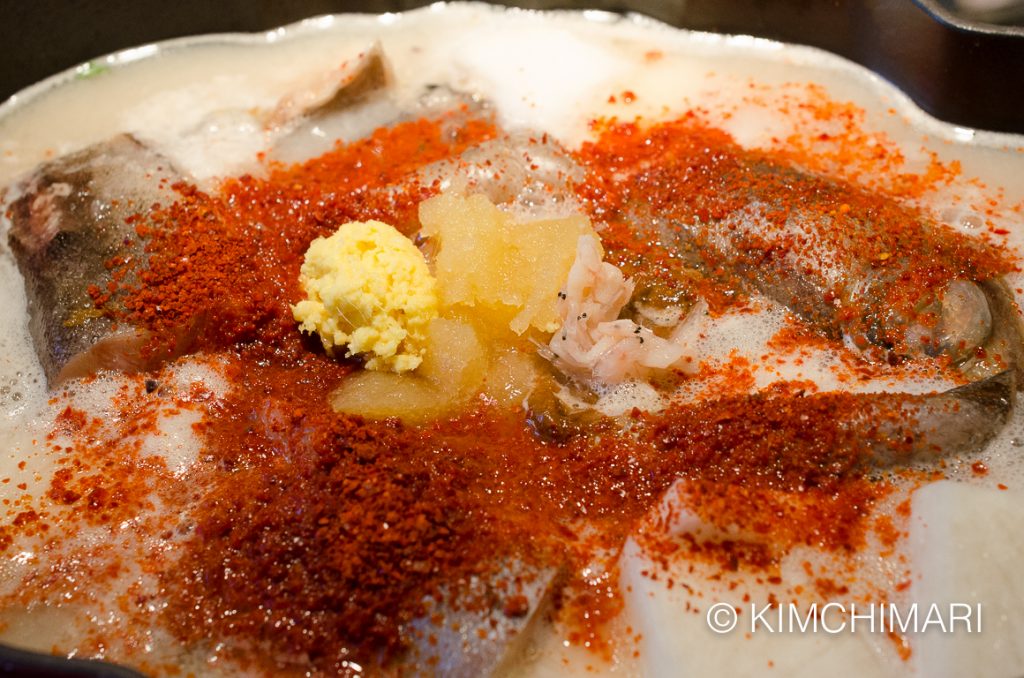
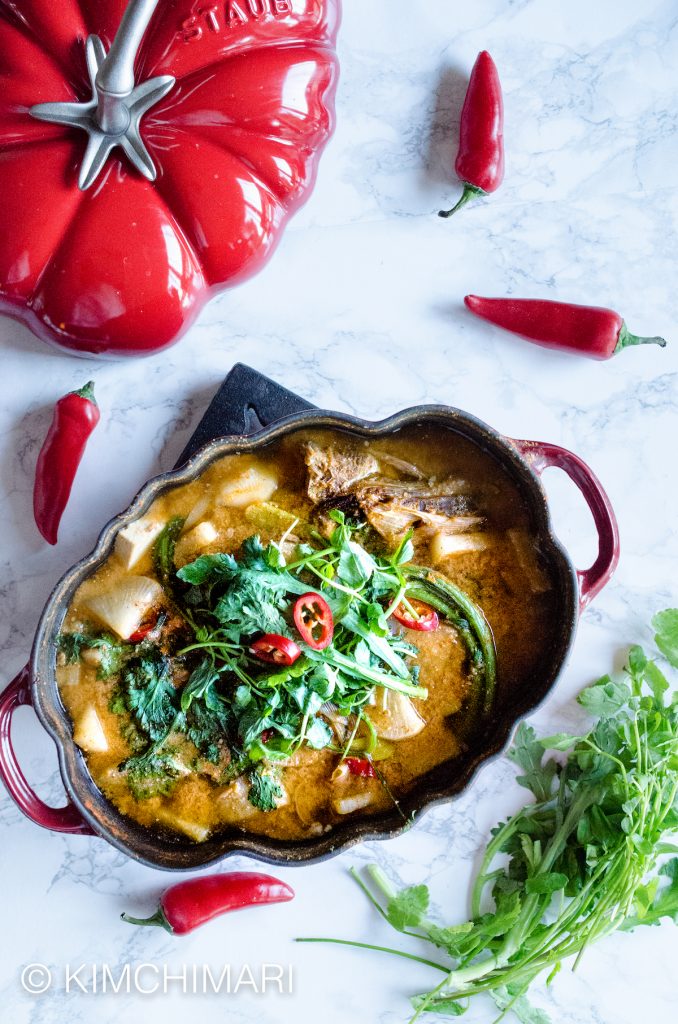
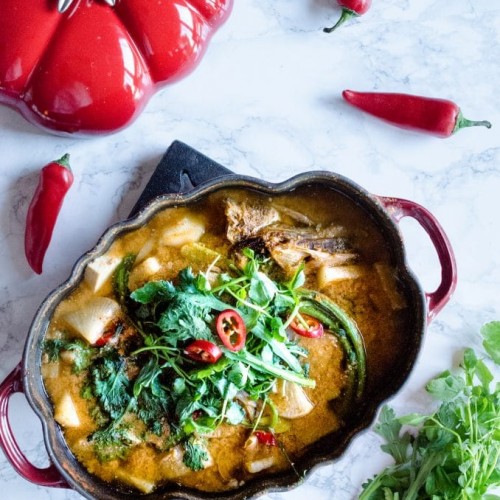
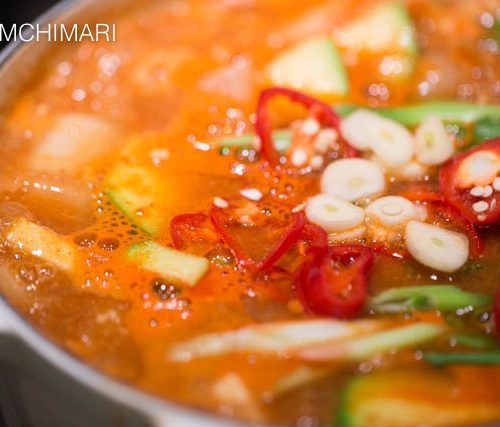
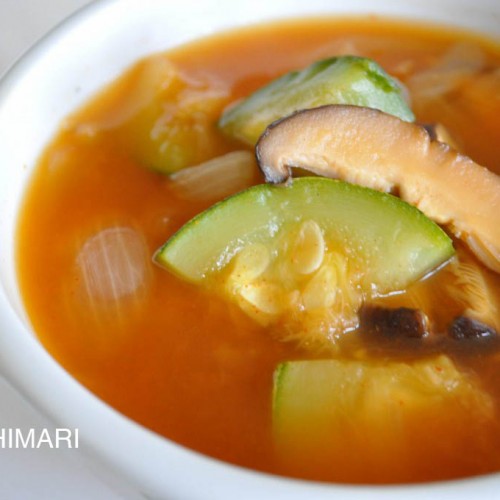

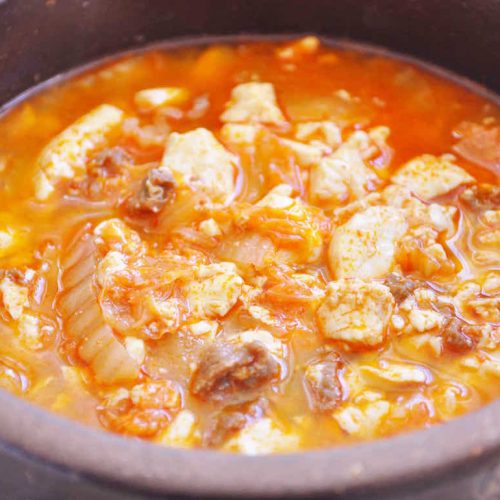
















Thank you for this delicious recipe! My family enjoyed it very much. It tasted authentic, as good as the Korean restaurants 🙂
I’m so happy to hear that. Thank you for the 5 stars!!
This is a very good spicy fish stew. I cut back on the gochujang and gochukaru, because last time I made a korean spicy fish stew my wife had problems handling the heat, I also subsituted a Japanese soup stock which was similar to dash. Give it a try a perfect stew for cold days.
I am glad to hear that! Yes, I totally agree it’s a perfect stew for cold weather. Thank you so much for the good feedback and the 5 stars!! Take care,